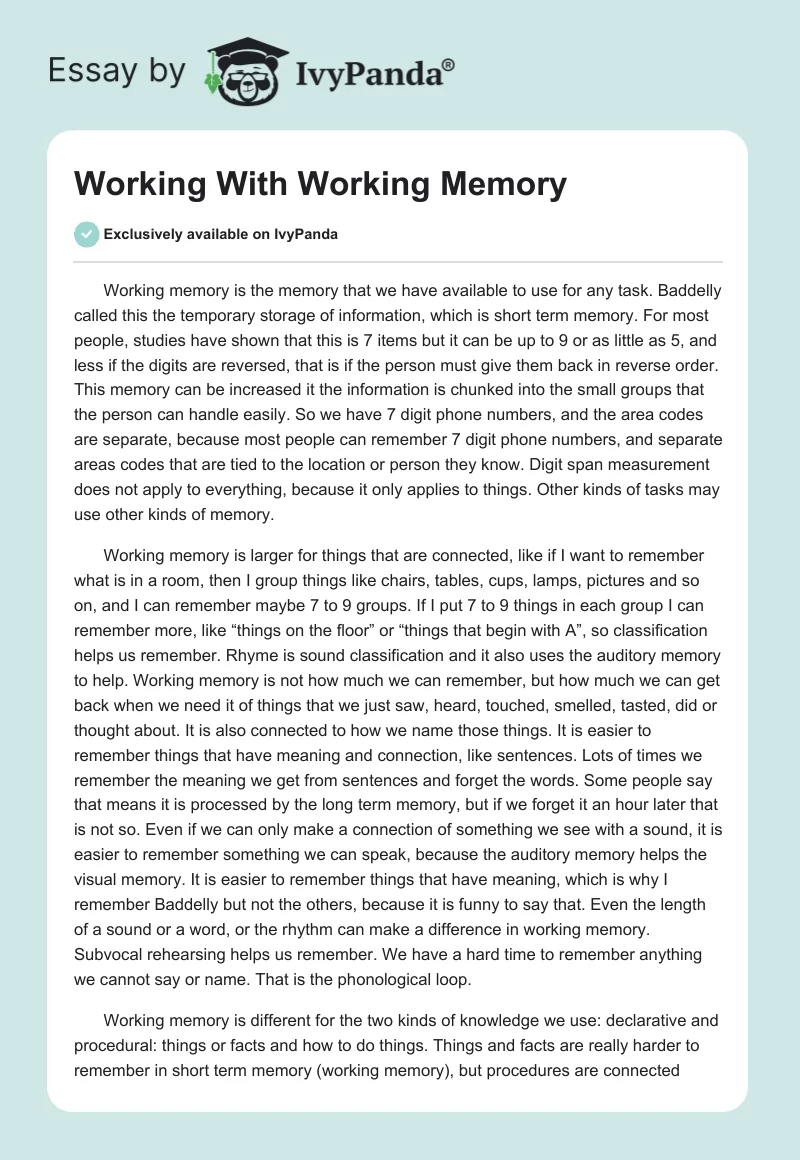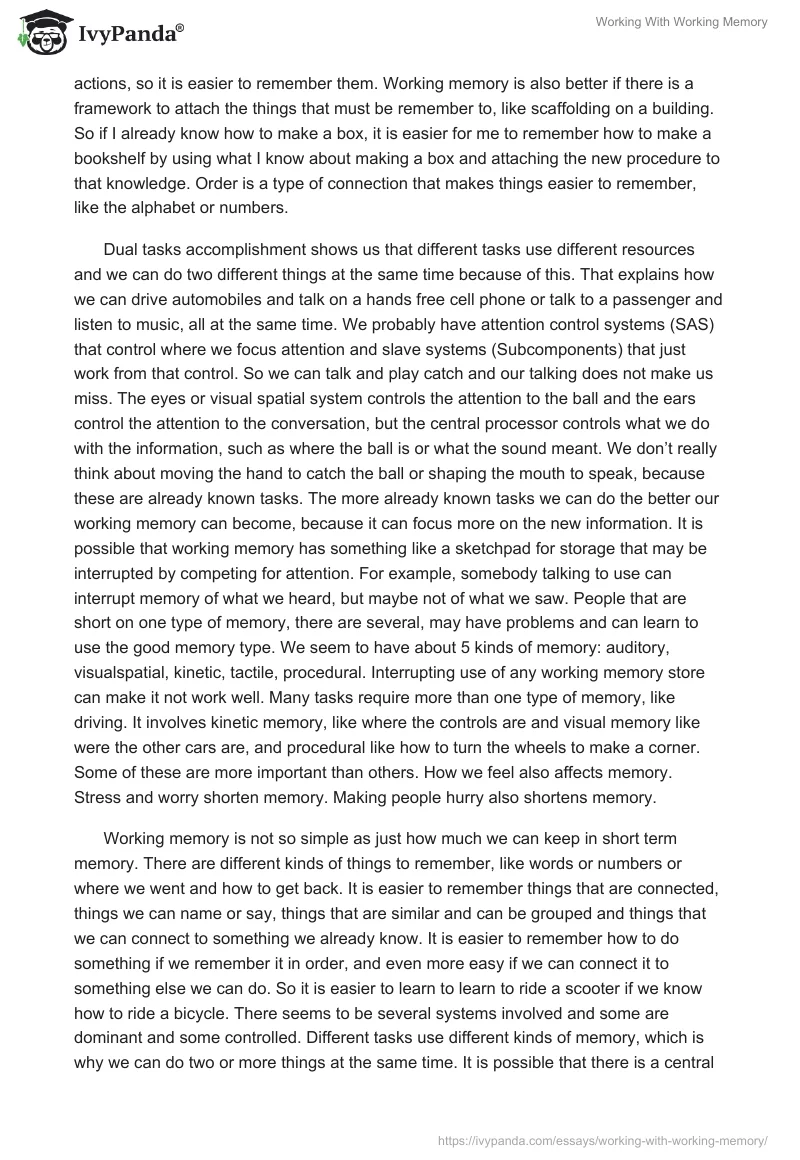Working memory is the memory that we have available to use for any task. Baddelly called this the temporary storage of information, which is short term memory. For most people, studies have shown that this is 7 items but it can be up to 9 or as little as 5, and less if the digits are reversed, that is if the person must give them back in reverse order. This memory can be increased it the information is chunked into the small groups that the person can handle easily. So we have 7 digit phone numbers, and the area codes are separate, because most people can remember 7 digit phone numbers, and separate areas codes that are tied to the location or person they know. Digit span measurement does not apply to everything, because it only applies to things. Other kinds of tasks may use other kinds of memory.
Working memory is larger for things that are connected, like if I want to remember what is in a room, then I group things like chairs, tables, cups, lamps, pictures and so on, and I can remember maybe 7 to 9 groups. If I put 7 to 9 things in each group I can remember more, like “things on the floor” or “things that begin with A”, so classification helps us remember. Rhyme is sound classification and it also uses the auditory memory to help. Working memory is not how much we can remember, but how much we can get back when we need it of things that we just saw, heard, touched, smelled, tasted, did or thought about. It is also connected to how we name those things. It is easier to remember things that have meaning and connection, like sentences. Lots of times we remember the meaning we get from sentences and forget the words. Some people say that means it is processed by the long term memory, but if we forget it an hour later that is not so. Even if we can only make a connection of something we see with a sound, it is easier to remember something we can speak, because the auditory memory helps the visual memory. It is easier to remember things that have meaning, which is why I remember Baddelly but not the others, because it is funny to say that. Even the length of a sound or a word, or the rhythm can make a difference in working memory. Subvocal rehearsing helps us remember. We have a hard time to remember anything we cannot say or name. That is the phonological loop.
Working memory is different for the two kinds of knowledge we use: declarative and procedural: things or facts and how to do things. Things and facts are really harder to remember in short term memory (working memory), but procedures are connected actions, so it is easier to remember them. Working memory is also better if there is a framework to attach the things that must be remember to, like scaffolding on a building. So if I already know how to make a box, it is easier for me to remember how to make a bookshelf by using what I know about making a box and attaching the new procedure to that knowledge. Order is a type of connection that makes things easier to remember, like the alphabet or numbers.
Dual tasks accomplishment shows us that different tasks use different resources and we can do two different things at the same time because of this. That explains how we can drive automobiles and talk on a hands free cell phone or talk to a passenger and listen to music, all at the same time. We probably have attention control systems (SAS) that control where we focus attention and slave systems (Subcomponents) that just work from that control. So we can talk and play catch and our talking does not make us miss. The eyes or visual spatial system controls the attention to the ball and the ears control the attention to the conversation, but the central processor controls what we do with the information, such as where the ball is or what the sound meant. We don’t really think about moving the hand to catch the ball or shaping the mouth to speak, because these are already known tasks. The more already known tasks we can do the better our working memory can become, because it can focus more on the new information. It is possible that working memory has something like a sketchpad for storage that may be interrupted by competing for attention. For example, somebody talking to use can interrupt memory of what we heard, but maybe not of what we saw. People that are short on one type of memory, there are several, may have problems and can learn to use the good memory type. We seem to have about 5 kinds of memory: auditory, visualspatial, kinetic, tactile, procedural. Interrupting use of any working memory store can make it not work well. Many tasks require more than one type of memory, like driving. It involves kinetic memory, like where the controls are and visual memory like were the other cars are, and procedural like how to turn the wheels to make a corner. Some of these are more important than others. How we feel also affects memory. Stress and worry shorten memory. Making people hurry also shortens memory.
Working memory is not so simple as just how much we can keep in short term memory. There are different kinds of things to remember, like words or numbers or where we went and how to get back. It is easier to remember things that are connected, things we can name or say, things that are similar and can be grouped and things that we can connect to something we already know. It is easier to remember how to do something if we remember it in order, and even more easy if we can connect it to something else we can do. So it is easier to learn to learn to ride a scooter if we know how to ride a bicycle. There seems to be several systems involved and some are dominant and some controlled. Different tasks use different kinds of memory, which is why we can do two or more things at the same time. It is possible that there is a central control system and it takes over for anything we already know. If our attention is interrupted we may not remember well. If we are worried, stressed or tired we may not remember as much. Some people who have deficits in some kinds of memory have to make it up by using the memory that works well, so people with short visual memory may rehearse what they see in their heads. Working memory is actually harder to make work well than long term memory. Maybe that is why patients lose short term memory but not long term. There are a lot of different theories about how working memory works. Probably all of them are partly right.


